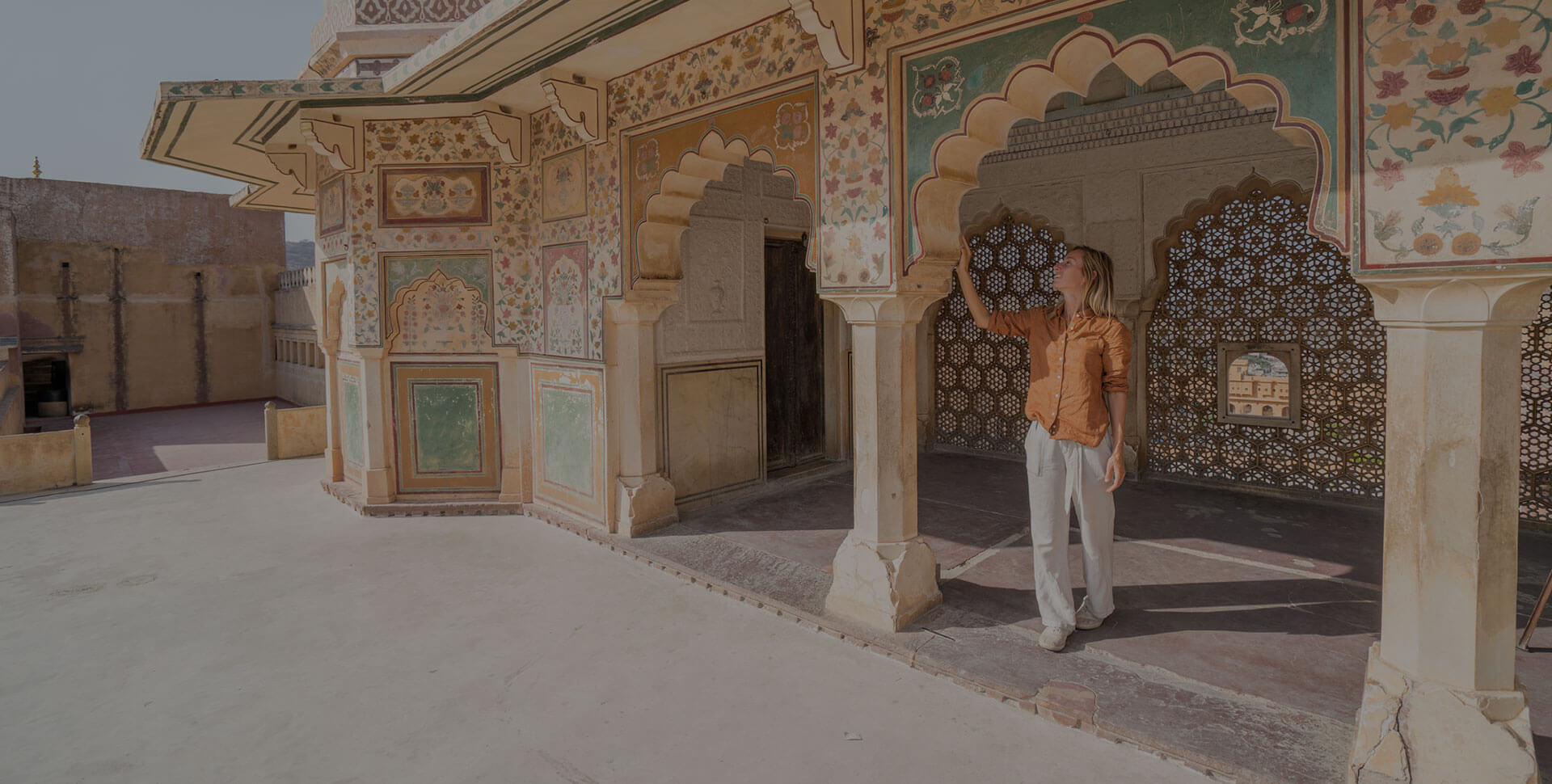Category: Cuisines of India
A Trip to Lucknow: For a Culinary Extravaganza

Much has been written about the city of Lucknow and its glorious past, which has contributed a lot in shaping up the art, history and culture of the Northern part of India. While the sights and culture of the city still bear testimony to past days, a lot has been changed over the years, but its grand gastronomic culture continues to flourish in the serpentine streets of this city. There are many expositions of the change, which city has experienced, but still managed to endure its legendary culinary reputation. The rich food culture in Lucknow could get along with the changing trends because of its simmering aroma and ubiquitous presence in the streets. In modern times, when chefs have been experimenting with many foods and flavours to add more dishes in a menu, the culinary prowess of Lucknow has not lost its distinctiveness and cult status with a consistent surge in followers, who swear by these yummy dishes. Whether it is about the secret ingredients, which are used to cook these delectable dishes or the expert tutelage, which is handed over from one generation to another – Lucknow is a paradise for a true gourmet aficionado.
The Legacy and richness
It has been proved that food can be therapeutic to the senses and if you put that in context, then Lucknow is certainly a dream-city. The most popular food joints are located in the old marketplaces of this city, such as Aminabad and Chowk, which are known for their exciting range of Awadhi foods. Though, some of the very best foods of Lucknow are easily available in its streets for everyone, they come with an excellent quality and unique flavour, which is perceptible everywhere, wherever this food is sold in the Lucknow city.
The main factor, which helped in augmenting the prominence and popularity of these foods of Lucknow is that they were under the patronage of the aristocrats and Nawabs, who helped in nurturing a legendary food culture in Lucknow, which was later on acknowledged and embraced by the many in the various parts of Northern India. In fact, it would be apt to say that Lucknow cuisines have contributed a lot in the proliferation of Mughalai food in North India. It was a matter of pride and a great honour to cook the meal for the Nawabs in those days. Likewise, it was a common practice among the most celebrated-chefs to try new things and spices to please and surprise their masters. So, those chefs tried new things with the extra flair, which led to the creation of many dishes. It was a golden era for the Mughlai food culture in India. The same style of cooking has been carried on till date, as the descendants of those chefs follow the traditions and blend all the important spices in the right proportion to make it a truly memorable experience for all those, who love foods. All these cooking skills have been acquired by making some extra efforts and by sticking to a rigorous routine related to preparation of food.
After India earned independence, the royal cooks had no option but to start their own food joints, which were later on turned into the famous eateries of Lucknow. The descendants of those royal cooks have now become the owners of these eateries and they take a lot of pride in continuing this legacy. Subsequently, these dishes have made inroads into the popular food markets of North India and earned a lot of followers everywhere. Some of the legendary dishes of Lucknow, which have become a household name in many parts of India are kormas, kebabs, kaliya, nihari-kulchas, sheermal, zarda, roomali rotis and warqi parathas among others. If these names remind you of that remarkable taste, then let’s talk about some stupendous Lucknow dishes, which are must-haves for all those who love food.
Tunday Kebabi
Let us begin with the top dish of Lucknow, which has an interesting story behind it. This 100-year-old Tundey Kebabi is situated on a bustling corner of the Aminabad area. This hugely popular eatery was started by the late Haji Murad Ali, who had only one functioning arm which earned him this title (Tunday means handicap). There are a few varieties of Kebabs available here, but the most famous of all is the Gilawati Kebab, which is the softest one and specially prepared for the then Nawab of Lucknow, Wajid Ali Sahib after he lost his teeth. The most terrific thing about this Kebab is that it simply melts in your mouth. Prepared by using more than 150 spices to get that exotic taste in these kebabas, these special delicacies have become synonymous with Lucknow and have earned innumerable lovers, not only in this city but all across India. In fact, some people visit Lucknow just to enjoy these kebabs.
Lucknowi Biryani
When it comes to this delicacy, one would instantly think about the legendary Hyderabadi Biryani, which is certainly the most popular one in India. Well, if it is about the popularity, then lucknowi Biryani is not far behind. The famous Dum Biryani of Lucknow is cooked over a low fire for hours in a sealed pan. This process of cooking gives a soft aroma to Dum Biryani, as meat retains its natural fragrance, which profusely seeps into the rice and gives that amazing flavour to it. The key to its great taste lies in using the right amount of ingredients and then cooking them for a specific period of time. The best Dum Biryani of Lucknow is sold at the Idris Dhaba, which is in the Chowk area.
Lucknawi Chaat
Chaat is one of the most favourite snacks of India. Like other popular dishes, Lucknow has its special chaat, called – the Tokri Chaat. Well, this chaat is prepared by using various spices and chutney to create that lip smacking taste. There are many varieties of Chaat in Lucknow, but one of the very best is Pani-batasha. This chaat comes in eight flavours and the popular food joints, which sell this chaat are: Gomti Nagar’s Neelkanth and Royal Cafe in Hazratganj.
Lucknawi Kulfi Falooda
If you have a sweet tooth, then you should not miss out on this dish. Well, this special dessert comes in various colours, but the most popular one is yellow. The place to enjoy this delicacy is Prakash Ki Kulfi, where they create it by mixing ice-cream with faluda and serve it with a tinge of saffron to satiate your taste buds. You would find many people around this food joint all the time, but this dish is served instantly.
Sheermals
Yes, it looks like a typical Indian naan bread, but it is sweet. This scrumptious naan is baked in a tandoor with precision to add that desired flavour in it and then mixed with warm milk and sugar. Finally, it is flavoured with some saffron to make it a truly refined delicacy.
Lucknawi Paan
It is a common tradition in many parts of India to have paan or betel leaves after a hearty meal. Well, Lucknow has its own paan but it is not like any other paan in India. It is more than just the usual ingredients because here they add extra or special ingredients to make a special paan for you.
South Indian Food: A Light Delight

When it comes to Indian food, there is a pre-conceived notion, as it is generally associated with curry-laden dishes or popular North Indian dishes like Butter Naan, Chicken Tikka Masala, Biryani and Chicken Kebabs. However, a bit of study would reveal that Indian cuisine has an overwhelming range of diversity and distinctiveness because it has been influenced by many cultures and civilizations over a period. Debunking the myth here, the cuisines of South India are equally popular among tourists as the North Indian cuisines are. The appetizing South Indian dishes are mostly rice based and come with low calories and easy to digest factors. Another main attraction of South Indian cuisine is that most of the dishes are a wonderful and a modest blend of lentils and rice, which are predominately used to prepare many delicious dishes like vadas, dosas, idlis and uttapams. Another interesting aspect is that most of the South Indian dishes are prepared by using a lesser amount of oil and spices, which make them light and easy-to-eat. To understand these amazing dishes, let’s first compare them with the Northern Indian cuisines.
Difference between South Indian and North Indian Food:
It is not possible to scrutinize the diversity of India’s cuisines by comparing South and North Indian foods, but we can at least do some basic comparison to get a fair idea about these delicious foods. North Indian food is dominated by curries and breads. The popular breads are: naan bread, rumali bread and rotis or common bread. In curries, we have palak paneer or a mixture of spinach and cheese; and then popular non-vegetarian dishes like Butter Chicken, Kadhai Chicken, and Chicken Kebabas. When it comes to spices, North Indian foods are prepared by using Garam Masala, which is a mixture of various spices like cardamom, Black and white peppercorns, Cloves, Cinnamon, Bay leaf and Cumin. Amchoor or dried mango powder is used as a souring agent in most of the North-Indian curries. As far as drink is concerned, people in North India love tea or chai – they usually complement their meals with a hot cup of tea.
South Indian food: South Indian foods are mostly based on the mixture of rice, lentils, and stews. Most of the popular dishes like dosa, idli, rasam and sambar are prepared by using rice crepe, lentils, tamarind and vegetable stew. When it comes to spices, South Indian dishes are prepeared by using Huli pudi or sambhar powder. Tamarind is used as a sour ingredient in preparing stews. Dried herbs and curry leaves are used in preparing soups. South Indian finish off their meals with a special coffee, made with chicory.
Now, let us look at common, yet hugely popular South-Indian dishes:
- Dosa: Primarily, dosa or masala dosa is a staple diet in South India. It is made from a batter of urad lentil and rice – to make it mildly spicy, a potato mixture is stuffed inside the large pancake. Dosas come in many forms: from plain dosa to paneer dosa. The pancake, which is a mixture of rice and dal remains the same, only the mixture is altered. Generally, Dosa is taken with sambar, which is a sour sauce made from vegetables, tamarind and tur dal. Other chutneys or sauces which are taken with dosa include coconut white chutney and tur dal red chutney. Other popular versions of dosa are: Mysore, onion, and rava.
- Vada: Prepared with a mixture of lentil and gram flour, it is a dense and fried donut. Occasionally, potato mash is used to provide that extra heft to a vada. This delicious snack is one of the most popular street foods in South India. You can eat it with sambar and other common chutneys or sauces.
- Idli: These delicious saucer-like cakes are prepared by using the batter of rice and black lentils. Fluffy, soft, and steamed, idlis are consumed with sambar and chutneys. The freshness and fragrance of steamed idlis attract everyone towards them.
- Banana Leaf Thali: Usually, a thali in India is considered as a buffet of delicacies. Well, this thali is different. Base is created with a large pile of rice, placed on a banana leaf and a chapatti roti and other ingredients are tin cups of curries, chutneys or sauces, papads and pickles.
- Curd Rice: Curd rice or yoghurt rice is prepared by cooking the rice with fried spices including coriander leaves, cumin, asafoetida and pain curd. This food is consumed a lot in South India to beat the intense heat.
Well, the South Indian cuisine would not be as creamy as North Indian food, but when it comes to taste – it is equally good.
Contact us for a tailor-made Culinary Tour of South India!





 +1-(765)-586-1210
+1-(765)-586-1210 +44-2030-2689-44
+44-2030-2689-44 +91 124 4361906
+91 124 4361906









 +1-(765)-586-1210
+1-(765)-586-1210 +44-2030-2689-44
+44-2030-2689-44

